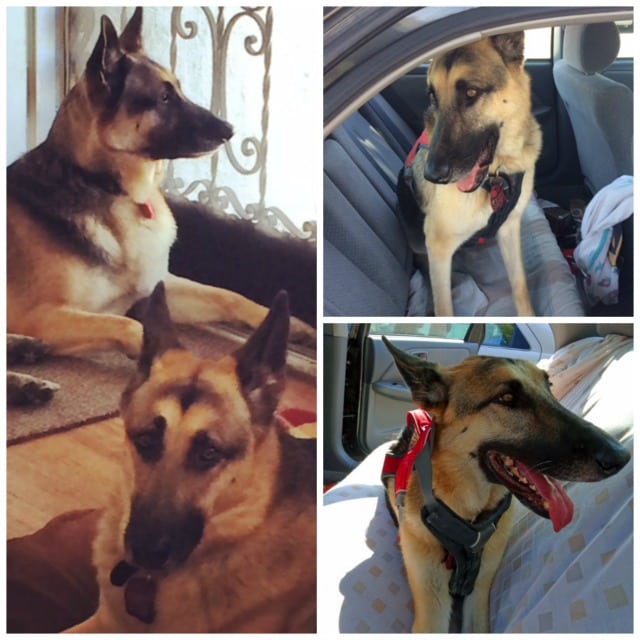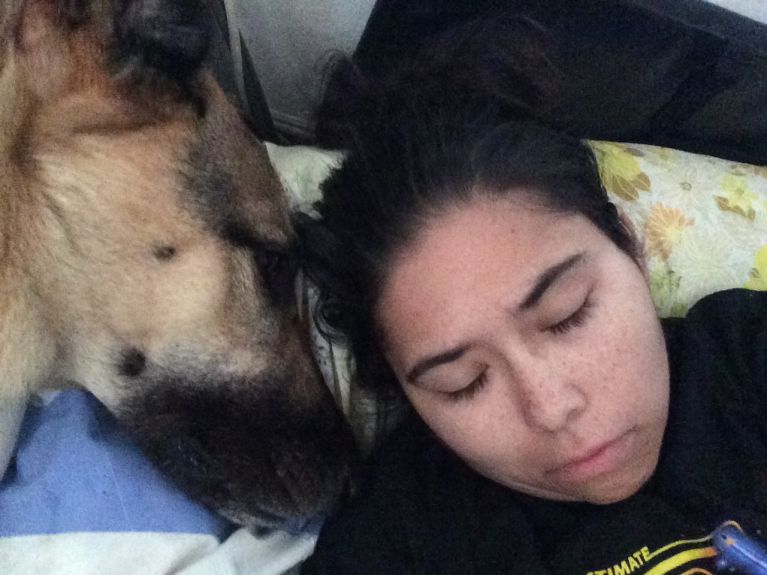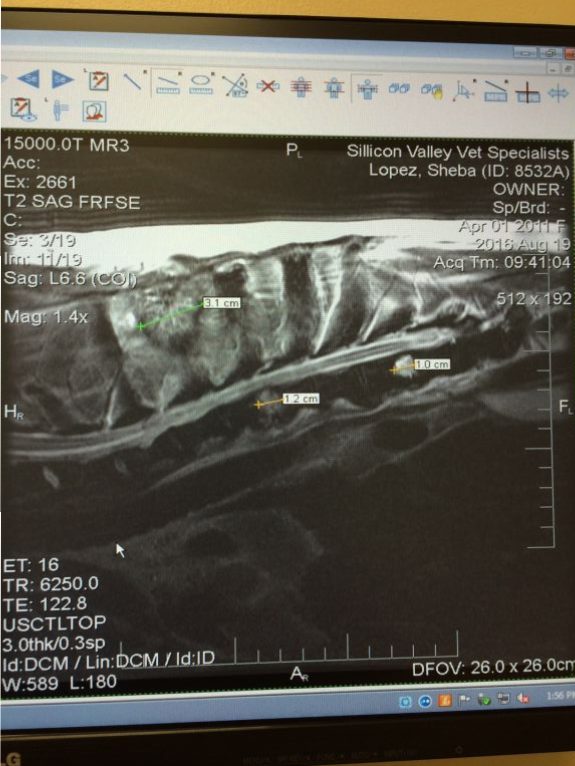Before a dog is believed to have osteosarcoma, vets will mention that the bone lesion could be a dog bone fungal infection. Of the two conditions, it’s the one we all hope for because osteo’s prognosis is usually so much worse. Unfortunately, fungal infections in dogs are rare. We used to think a fungal infection was the better diagnosis of the two, but then Sheba joined us and we learned just how devastating this condition can be.
Sheba, a gorgeous German Shepherd, was only a Tripawd for a few weeks. The infection took her so fast that even the best scientists who study mycology had trouble deciding on an exact diagnosis. Her Mom Cynthia was kind enough to share details about what happened when their fight began, and ended so recently. We are forever grateful to her for contributing this guest blog post during her time of grief.
A Dog Bone Fungal Infection? “At least it’s not cancer…”
We started this journey shortly after Sheba finished healing from a TPLO on her left leg. The right leg started showing signs of stiffness and slowly she began shifting almost all her weight to the TPLO leg. Worried she might damage the plates and screws, we took her to our vet to get checked out. X rays showed arthritis in the right leg and the TPLO was fully healed so there was no worry about damaging that. We figured she’d blown the other CCL and would need a TPLO on the right as well. So we saved up our money and went in for surgery May 23, 2016.
As soon as the traveling surgeon opened the joint space he realized what ever Sheba had going on wasn’t arthritis because it was progressing too fast. He took some samples of tissue to run pathology and closed her right back up. We were given 3 possibilities:
- Bacterial infection
- Fungal infection
- Or cancer.
Right away it was clear there were no bacteria present. So we started researching cancers and fungi. On the cancer side, osteosarcoma and chondrosarcoma were the likely suspects. If it was fungus we thought it was likely Valley Fever, since we don’t get a lot of fungus here in CA. Having worked in an oncology clinic I knew in humans Valley Fever can be misdiagnosed as lung cancer so it wasn’t too farfetched.
Initial histopathology came back the next day: could be cancer, could be fungus. Seriously, the pathologists couldn’t agree on a diagnosis! Tissues samples were consistent with fungal infection and undifferentiated cancer. X rays suggested cancer, but when the special stains for fungus were run at our request, they came back a week later with a preliminary diagnosis of Blastomyces dermatitidis. Umm, helloooo! We live in California…we don’t have Blasto. But lots of other stuff looks like it so we had them run another test that would identify some of the more common fungal diseases. That came back inconclusive.
While all this was going on, Sheba’s leg was getting worse. It had completely atrophied, she had a pressure sore and I’m pretty sure we were losing circulation because the few days before amputation the foot was VERY cold. We went in on June 24 for a consult with an internal medicine doctor. She handed us right over to the surgeon, Dr Appel, and wished us luck.
We already knew the leg had to go and the she agreed so amputation was scheduled for June 30. She sent us home with a Fentanyl patch and some gabapentin. On surgery day the entire leg was removed and more samples were sent away for pathology. Took until July 6th to get a definitive NOT CANCER, and the next day the lab said “Hey look: Aspergillus!” Great, we were already on itraconazole and susceptibility results would later come in saying it was the best drug for her fungus. What didn’t quite fit was the fact that Aspergillus is typically inhaled, affecting the lungs before becoming systemic. And Sheba’s lungs were clear.

Fast forward to the end of July – Healing went stellar, except for the 1.5″ section of incision that opened up a few days after her stitches came out. Everything seemed to be getting better, and we were looking forward to several more months or even years with Sheba. When the final set of stitches came out August 2nd we were due for x rays and blood work to monitor the spread of disease and whether the itraconazole was starting to harm her kidneys or liver.
Unfortunately, what Dr Appel had been eyeing as potentially just early signs of arthritis was starting to look like a fungal lesion on the spine. German Shepherds are most susceptible to nasal and spinal fungal infections. While trying to determine drug susceptibility, the lab had continued crowing and studying Sheba’s fungal cultures. When they came back with a revised identification of Penicillium spp. (seriously? its not rocket science!) the cultures were sent to the Fungus Lab at the University of Texas at San Antonio. I hear they’re great for weirdo cases like Sheba’s.
Sheba had never had much of an appetite after surgery, but she started refusing food, eating only a few favorite foods. At this point Dr Appel decided we needed a neurological consult, so given all of her recommendations we picked the guy with GSD experience and a black shepherd of his own.

On August 18 we had a consult with Dr Harrington. Sheba had no neurological signs but he recommended an MRI to see the extent and shape of the fungal lesion. He also wanted us to see the internist for a medication consult regarding the antifungal dose. We were told Sheba refusing to eat was typical GSD behavior and to just feed her whatever she wanted when she wanted it.
The next day we dropped her off early for sedation and the MRI. Dr Harrington called around 11:30 asking us to come by between 12 and 1 for the results and to meet with the internist. The MRI showed 3 lesions, the one big one between the dorsal spinal processes between her shoulder blades, and then two smaller 1cm lesions in the vertebral spaces further down the thoracic spine.
The internist, Dr Moore, thought even though the pathology report says Penicillium spp. it could still be Aspergillus spp. and since that has a better prognosis and similar treatment with more empirical evidence that we’d treat as if it was Aspergillus. He recommended doubling up on the itraconazole and checking back in a month. That was Friday.

Over the course of the next week, Sheba continued to refuse food (once or twice a day she’d eat a jar of baby food or a few slices of deli meat) and she would spend most of the day sleeping in her room, only coming out to go potty then going right back to sleep. Our beagle mix, Nikko, started hanging out in the doorway watching Sheba, one time we saw him making a motion like he was waving to her.
I noticed Monday or Tuesday that she was having a hard time walking after pooping, like squatting was too much stress on the body. We started using the rear sling in addition to her Ruffwear Webmaster Harness to help her get around. On Wednesday Dr. Moore called to discuss radiology and lab reports. The UT preliminary fungal ID came back as Rasamsonia spp. which is often mistaken for Aspergillus or Penicillium but has a much worse prognosis. Sheba continued to isolate, eat very little, and began constant panting at night even in her sleep.
Friday morning (August 26) she got up for her car ride, hopped out to the car ok, then after her ride headed off to my room to sleep. She was still sleeping in my room when I came home at 3. At 4 I realized she hadn’t been out to potty since her car ride so I tried to get her up to go out. She was unable to sit up one her own without help so I grabbed the rear sling to help her stand. My aunt helped me get her up but she began knuckling and peed in the hall becoming very agitated, trying to get to the front door. So my aunt took her out to the car while I called Dr Harrington.
He believed she had developed a spinal infection and said we should bring her in. He suggested an MRI and spinal tap to relieve pressure while I was on the phone with him but we already knew it was time to let her go. When we got to the clinic Sheba tried getting out of the car with my aunt but then sat down and couldn’t move anymore. They brought her into the clinic on a stretcher and straight into an exam room.
Dr. Harrington checked the reflexes in the remaining rear leg and Sheba screamed. There was very little movement in response to the stimulus. He started giving us treatment options but we told him it was time to let her go. I don’t think he thought we’d make that decision so quick, but he was kind enough to send in a great tech to put in the catheter before he administered the euthanasia himself.
I know she’s in a better place now, with a perfect body and all the carrots and Wubbas a dog could ever want.”
Thank you Cynthia, and thank you Sheba for expanding our knowledge about fungal infections. Some day somebody will be helped by your story. Your fight was not in vain.
I know this is several years later but we are starting this process with our Aussie Shepherd. My husband and I have opted for amputation of her right back leg as opposed to doing biopsies and waiting for a diagnosis and the lesions being left in her body. I was second guessing my decision and decided to search for additional information about cancer v fungal infection and found this story about Sheba. Thank you. This confirms our decision as far as I am concerned. All xrays read by specialists indicate her leg is the only place affected right now. Tomorrow it goes. Thank you and rest well Sheba.
Best wishes for your pup! For help finding all Tripawds resources and assistance programs, start here.
I’m so sorry to read about Sheba’s story. May she be dancing joyfully over the rainbow bridge.
We similarly dealt with having to put our 13 year old male golden doodle to sleep after detecting the presence of several small lung lesions and two lytic bone lesions on the front legs (one on each, wrist and elbow). We did not perform biopsies. At the end of his life, he only chose to eat fresh meat the last week and would only get up (with our help supporting his rear legs) to relieve himself and then would return to 1 of 3 resting beds he had.
Interestingly our dog struggled with skin and ear fungal infections the last 10 years of his life. We were never able to clear them no matter the treatment sadly.
I now wonder reading this if there was a connection between the two and if we could have been more aggressive sooner. Thank you for the information.
We live in west Texas and in feb our dog was diagnosed with valley fever. Last week we noticed he wasn’t himself and ask for any more test they could do. They did abdominal and now say it is liver cancer along with valley fever.Is it possible it wasn’t valley fever and cancer all along?
Hi Joyce,
I’m sorry your dog is having such a ruff time. If this doesn’t sit right with you, see if you can get the Texas A&M Diagnostic Lab to take a look at the pathology. They are among the best in the world for figuring out complicated cases. Best wishes to you both. Hope you get some answers.
The bone fungal infection is also known as ‘Osteomyelitis’- which is nothing but the swelling of the bone or the bone-kernel(bone-marrow) caused by the existence of the microbes or fungus. It’s a fungal infection. Sometimes any small surgical treatment can also bring this ailment into existence. If any wounds are left exposed to a specific parasitic bacteria, then also your canine friend may also suffer from such bone infirmity. Fever, soft tissue inflammation, pain are some of the symptoms of Osteomyelitis. If you ever sense that your canine friend might have a bone disease, then you should directly take him to a skilled veterinarian who can perform a series of physical exams, and recommend you the best possible preventives to save your dog’s life from the extremity of this fungal indisposition.
Bettina, a sight hound mix, has a fungus on her left wrist. Her bone biopsy has been send to a second lab because the first one could not identify it. Last Spring she had a bone biopsy on her left rear knee and it was finally diagnosed as arthritis due to an old injury. She is not quite 3. I’ve had her since February 2019. Would really like advise. Her bone biopsy on her wrist was done 13Jan2021.
@Lasses, whenever you don’t like the direction a diagnosis is going, it’s always best to get another opinion. University teaching hospitals are (in our opinion) the best places to go when a diagnosis cannot be reached. We wish you and Bettina a quick resolution and speedy recovery.
I’m so sorry I missed this before but Sheba’s story means so much to this site and across the doggie planet. Thank you so much for sharing. You are beyond brave and your ability to tell your story and make the decisions you made are not only selfless but admirable. It’s amazing how fast this happened and how many hard decisions you had to make in the process. I’m sure Sheba’s story will live on just like her beauty (she’s a gorgeous GSD!) and her sweet personality. You did the best you could and it’s all we can do in the end. Thank you again and may you and Sheba live blissfully without pain from here on out!
Cynthia, please know that you and the BEAUTIFUL SHEBA will have a lasting impact on this community on so many levels. Your courage, her courage, your devotion to each other, the depth of your love for her and hers for you, as well as the insightful information you so bravely shared…….yeah….you and Sheba have touched our hearts forever!
Sheba’s life was full of purpose and meaning. She truly, truly, trulyl loved a life of meaning and a life that made a difference,!!
As gut wrenching as your grief is now, I hope you can find some comfort in knowing the gifts Sheba brpught us all will NEVER be forgotten!
These pictures show a beautiful and happy Soul, inside and out. And Sheba wants you to remember the thousands and thousands of happy days she shared with you.
When you can, I hope you’ll share more of your lofe with Sheba AND some more beautiful pictures. We are here for you and with you.
Lots of love
Sally and Alumni Happy Hannah and Merry Myrtle and Frankie too!
Thank you for the information shared in your heartbreaking story. So sorry for the loss of your beloved furry family member Sheba!
Thank you for sharing your story even in this difficult time. I know how hard this was to share. Thanks for letting us see some of her journey and yours. She was a beautiful baby.
hugs
Michelle & Angel Sassy
Thanks for sharing beautiful Sheba’s journey. You have opened many of our eyes to the horrors of fungal infection. I know you’re still devastated by your loss and I hope you find peace for your hurting heart.
Thank you for sharing your story. I know that I was one of the ones cheering when you found out that it was not cancer. It is just horrible how quickly this all developed, and how hard it was to try to get answers as to what it was. She was a beautiful dog, and will be missed. Do you know how she acquired whatever it was? Until researching prior to my Otis’ amputation, I had never really heard about fungal infections in dogs.
Thank you for sharing your story. We are going through something similar now after TPLO surgery Dec 2020. Currently Buttercups leg is a huge mass she is unable to walk without a sling. Biopsy, ct scan was inconclusive for bone cancer. We just asked for a fungal blood work panel today it takes 8 days to come back. Reading your story i felt I could relate with all the vet visits and unknowns. We are hoping for answers if she has fungal and hope we are able to treat it before it’s too late
Naela, I’m sorry you guys are dealing with this. Please join us in the Tripawds Discussion Forums so we can help you better. Keep us posted!